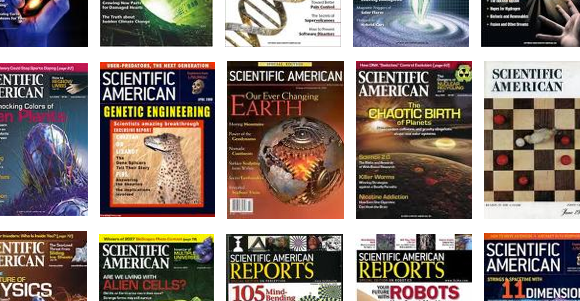Scientific American, the magazine I always put in the “not as entertaining as Popular Science but probably more about actual science” box as a kid, triumphantly launched their new Scientific American Blog Network today. It professes to be a place that “unites editorial, independent and group blogs under the magazine’s banner.”
As one might expect, this is something of an old media/new media move, according to overseeing editor Bora Zivkovic “We are trying to eliminate the artificial line between ‘blogging’ and ‘journalism’ and focus on good, accurate writing, no matter what form it comes in or what software is used to produce it. Our bloggers are a part of our team, as ‘continuous correspondents’ or ‘full-time freelancers’.”
But the network really gained our attention for its vital statistics:
From Zivkovic, again:
When I put together this group, with such diverse interests and styles, it was not surprising to discover that, without really having to try hard to make it so, they also display diversity in many other areas: geography, ethnicity, gender, sexual orientation, age, personal/professional/scientific background and more. This is something that is important for science, and is important in the science blogging world.
So, as I expect that several of you are already counting, let me make this easy for you. We have 47 blogs with 55 bloggers. Of those, our editors and staff make up 13 people (8 women, 5 men), while independent bloggers make up the difference with 42 of them (25 women, 17 men). That is a total of 22 men and 33 women writing on our network. The age ranges from 22 to 58, with the mean around 32 and median around 31 (at least when including those who are willing to admit their age).
That’s right: there are a ton of awesome blogs here written by awesome sciencey women. A few highlights, in alphabetical order:
- Anthropology in Practice, by Krystal D’Costa, which will “look at the ways the urban environment shapes urban culture and affects the way we relate to each other – both offline (see Hold that door, please! Observations on elevator etiquette) and online.”
- Budding Scientist, by Anna Kuchment, who will “with the help of Scientific American editors, scientists, and other contributors… will share ideas for involving kids in science early and often. She will also bring you up to date on the latest news about science education, encourage you to share your own ideas and projects, and answer your questions.”
- Cocktail Party Physics, by Jennifer Ouellette, the director of the Science & Entertainment Exchange, whose published books include The Physics of the Buffyverse, Black Bodies and Quantum Cats: Tales of Pure Genius and Mad Science, and The Calculus Diaries: How Math Can Help You Lose Weight, Win in Vegas, and Survive a Zombie Apocalypse. As for us at The Mary Sue, we know we’re doing something right when she retweets us.
- Context and Variation, by Kate Clancy, who has this to say about its subject matter:
My work focuses on understanding human biological variation, particularly in women. A lot of people have developed this idea – from the one biology class they took in high school, what they read on the internet (er…), or what they hear from a medical professional – that there is one right way for a body to be. And if you don’t fit into this narrow interpretation of right, or normal, you are pathological or subclinically pathological.
The way anthropologists study the body challenges this idea.
- Science Sushi, by Christie Wilcox, for which editor Zivkovic has this to say “When Christie Wilcox dissects a scientific paper or an issue, that is the sharpest, most definitive and usually the final word on the subject.”
- The Urban Scientist, by Danielle N. Lee, who will be “blogging about science education and outreach, especially to women and minorities.”
This is but a sample of an extensive list of blogs written by a science writing staff that’s two-thirds female, check out the list itself in its entire to find even more science ladies to read and follow.








Published: Jul 5, 2011 02:55 pm